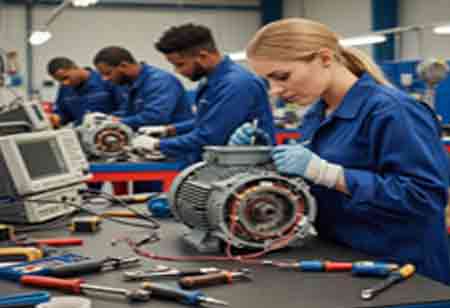Thank you for Subscribing to Electrical Business Review Weekly Brief
I agree We use cookies on this website to enhance your user experience. By clicking any link on this page you are giving your consent for us to set cookies. More info
Enhancing Operational Efficiency: Insights into Electrical Motor Repair
Electrical motor repair services are essential for industrial efficiency, driven by aging infrastructure and AI advancements. Predictive maintenance improves operations, while challenges include labor shortages and fragmented data systems.

By
Electrical Business Review | Friday, July 25, 2025
Stay ahead of the industry with exclusive feature stories on the top companies, expert insights and the latest news delivered straight to your inbox. Subscribe today.
Electrical motor repair services form the backbone of industrial efficiency and operational continuity across the manufacturing, power generation, transportation, HVAC, and oil and gas sectors. As electric motors age or malfunction, timely repair and maintenance become critical for avoiding costly downtime and sustaining energy efficiency. The evolving market dynamics, applications, and digital trends in electrical motor repair services reflect a growing demand for predictive maintenance, faster diagnostics, and sustainable repair practices.
The electrical motor repair service industry is experiencing a pivotal transformation driven by technological advancements, particularly AI and digital diagnostics. As industries modernize and focus on sustainability, the demand for efficient, accurate, and predictive maintenance solutions grows. Overcoming challenges like labor shortages and standardization issues will be key to meeting the rising market needs. In this evolving landscape, innovation is not just a competitive advantage; it's a necessity for survival and success.
Market Drivers and Technology Implementation
The demand for electrical motor repair services in industrial and commercial sectors is rising, driven by several factors. The aging global infrastructure and long operational life of industrial equipment have created a growing need for repair and refurbishment rather than full replacement. Many motors today are decades old and require frequent servicing to maintain optimal performance. Energy efficiency regulations and environmental concerns influence companies to sustain their motors at peak performance.
Repairing and upgrading old motors with more energy-efficient components is often more economical and sustainable than purchasing new ones. The shift has increased the value proposition of reliable motor repair services. The tools help detect anomalies early and reduce guesswork, making maintenance more precise. Using Computer Numerical Control (CNC) equipment in winding and machining has enhanced repair accuracy and minimized human error.
Electrical motor repair services have applications beyond traditional manufacturing. They are vital in industries like renewable energy (e.g., wind turbines), water treatment facilities, mining operations, and public transportation. Urban infrastructure relies heavily on electric motors, including pumps, elevators, HVAC systems, and electric transit. Consistent and high-quality repair services are essential for uninterrupted operation.
AI Integration and Market Impact
AI is revolutionizing the electrical motor repair service market by enabling predictive maintenance and advanced diagnostics. Using machine learning algorithms, AI systems can analyze motors' historical and real-time performance data to detect subtle patterns that indicate wear or impending failure. This predictive capability allows companies to schedule maintenance before breakdowns occur, reducing downtime and saving costs. Smart sensors and IoT devices are increasingly embedded into motors to continuously monitor parameters like temperature, vibration, and load.
The sensors feed data into cloud platforms that apply AI to recommend maintenance schedules and suggest potential repairs. AI also supports automated fault diagnosis, helping technicians quickly identify issues without lengthy manual inspections. The latest trend is digital twin technology, where a virtual replica of an electric motor mirrors the performance of the real unit. The twins simulate real-world operations and predict how motors behave under different conditions. The approach helps fine-tune maintenance plans and optimize energy consumption.
Using AI-powered tools, repair technicians can diagnose problems remotely and recommend solutions, reducing service time and travel expenses. AR tools are finding traction, providing field technicians with hands-free instructions or remote support from specialists during on-site repairs. The impact of AI and digital tools is profound. Companies benefit from increased operational uptime, better asset management, and reduced lifecycle costs. AI enhances decision-making and fosters a proactive maintenance culture. The shift from reactive to predictive servicing represents a critical evolution in the market.
Industry Challenges and the Need for Growth
Repairing motors requires expertise in mechanical, electrical, and thermal systems, and the aging workforce poses a gap in technical skills. Many companies struggle to find adequately trained personnel capable of handling complex diagnostics and AI-enabled systems. Organizations invest in workforce development programs, certifications, and partnerships with vocational institutions. Incorporating digital training tools, such as AR-based simulations and online certification platforms, is helping to onboard new technicians faster and more effectively.
Fragmented data architectures often hinder predictive maintenance. The solution lies in adopting industry-wide standards for motor diagnostics and leveraging open-source platforms that enable easier integration and interoperability. Cost is a barrier, especially for small and mid-sized firms. Advanced tools and AI platforms require an upfront investment that not all companies are ready to make. The long-term ROI from improved uptime and energy efficiency is compelling. Governments and trade organizations increasingly offer grants or incentives to support digital adoption in industrial services.
The need for reliable electrical motor repair services is more significant than ever. With industrial automation on the rise, motors are becoming more critical to business operations. Any disruption in motor function can halt entire production lines or transport systems. The push for sustainability means companies must extend the life of existing assets rather than replace them. Electric vehicles, wind farms, and smart buildings rely heavily on electric motors, creating new verticals for service providers. Companies that can adapt to smart maintenance, invest in AI, and overcome workforce gaps will lead the future of this industry.








